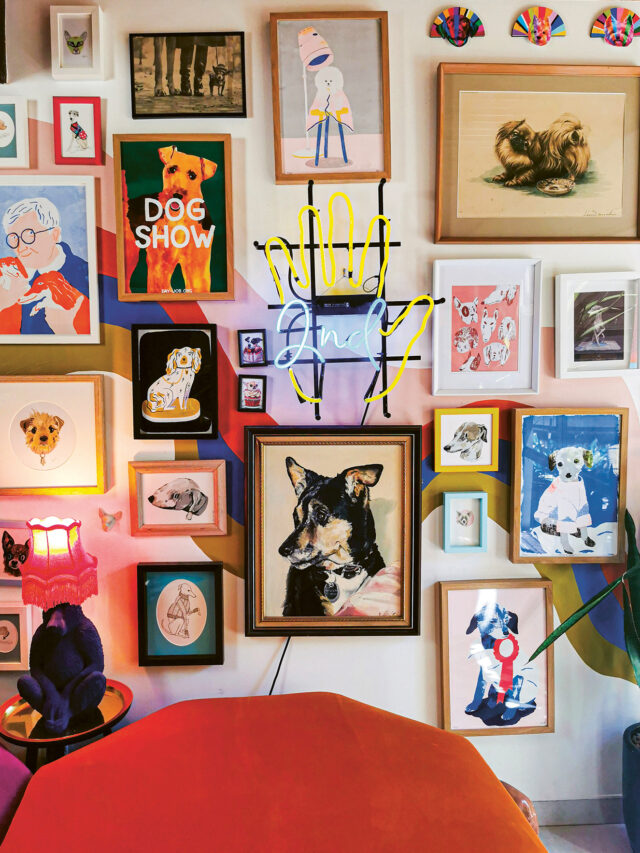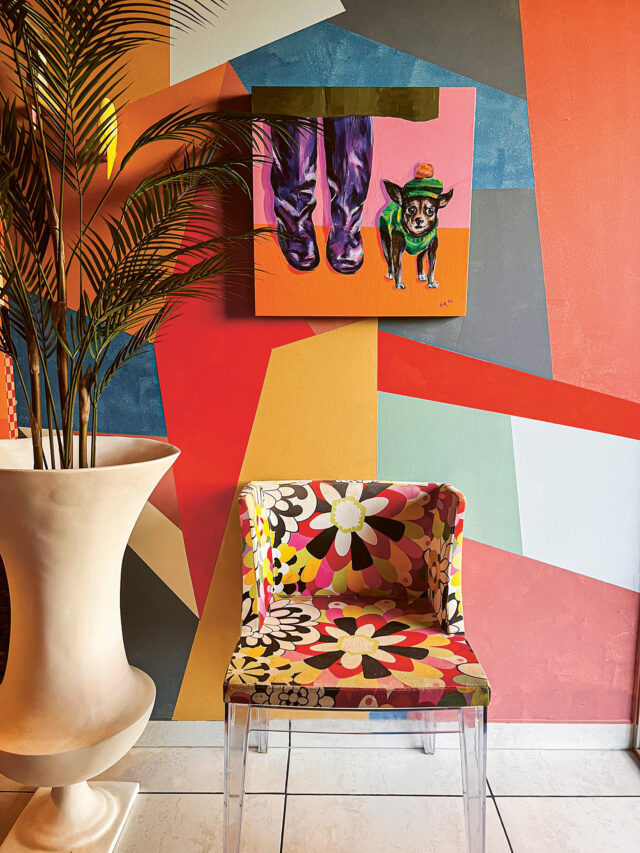The following is an edited extract from the new book MUCH: A Maximalist’s Guide to a Creative Home by Evie Kemp.
Supporting living artists is a thrill and a delight. And while I do believe everything can be art, there is something so special about buying art from an artist if you can. I feel like I’m just coming into my art-buying era and it’s what I’m most excited about. Social media is a brilliant way to find artists and buy pieces from them directly – I recommend signing up to newsletters of artists you love to be first to know when they release new work or exhibit.

Buying art is not just a matter of decorating your space, but investing in pieces that resonate with you personally. Here are some tips to guide you through the process:
1 Follow your heart
Most importantly (and this applies to everything, not just art) buy what you love. Art should evoke emotion and add personal value to your space. If a piece catches your eye and you keep thinking about it, that’s a good sign it belongs with you. Remember, you’re the one who will live with the art, so it should speak to you on a personal level.
2 Set a budget
Art can range from surprisingly affordable to significantly pricey. Setting a budget before you start looking can help narrow down your options and keep your spending in check. Remember, there are gems at every price point, and starting an art collection doesn’t necessarily mean breaking the bank.


3 Educate yourself
Spend some time learning about different art forms, styles and artists. Visit galleries, art fairs and museum exhibitions to get a sense of what appeals to you. The more you know, the more confident you’ll feel in your art-buying decisions.
4 Consider the space
Think about where the art will go in your home. Consider the size, colour scheme and lighting of the space. Art can be a focal point or complement your existing décor. Sometimes, envisioning where a piece will hang or stand can help solidify your decision to purchase it, especially if it’s an investment. Some galleries and artists, especially online, can digitally mock up how an artwork would sit in your space which can be super helpful.
5 Support emerging artists
Buying from emerging artists not only helps support their careers but can also be a way to acquire original works at more accessible prices. Plus, there’s something special about discovering and nurturing new talent. Keep an eye on local art schools’ graduate shows, small galleries and online platforms that showcase up-and-comers.


6 Ask questions
When buying art, don’t hesitate to ask the seller or artist questions. Learn about the piece’s story, the materials used, the artist’s background, and the care instructions. This information can add value to the artwork and deepen your connection to it. Artists and gallerists love to talk about art, so never think that you’re wasting their time asking questions.
7 Buying art online
The internet has made art more accessible than ever. Online galleries, social media platforms and artist websites are great places to discover art from around the world. Just be sure to verify the site’s credibility and understand the return policy before making a purchase. Many artists do studio sales via social media – often these will be more affordable pieces like sketches or artist’s proofs. This is such a fun way to buy art directly from an artist.


I once enquired about a painting from a Dutch artist I had discovered through Instagram and loved his work. The painting was out of my budget but the artist very kindly let me know that he had a collection of art cards coming out soon as a collaboration and I was delighted to buy them! I’m still hoping to buy an original one day. If I hadn’t asked about the painting – which I was shy to given I guessed it would be more than I could afford – I would never have known about the prints which I still treasure today. This is a sign to engage with artists you love, even if you’re not necessarily in the market right now.
8 Think longterm
Consider how the art will grow with you as your taste may evolve, and your living situation might change. Art that has a timeless appeal or carries personal significance is likely to remain a cherished part of your collection, whereas art bought predominantly as décor or because it fits a colour scheme will probably fail.
9 Enjoy the process
Art collecting should be enjoyable. Each piece you choose is a reflection of your journey, tastes and experiences. Enjoy the process of searching, discovering and selecting pieces that move you. Don’t allow yourself to get stressed or pressured into finding the perfect piece. If you’ve got a gap on the wall, stick something else up in the meantime like a nicely framed print – the right artwork will find you eventually.
If you’re new to collecting and worried that the art scene can be intimidating, don’t be. Start popping into galleries and having a good look. It’s usually pretty easy to see which ones are more open and accessible, so if you’re nervous start with those, or at a student exhibition. Artists want to sell art – you’ll be more than welcome, I promise you.
Gallery walls
There are a billion how-to guides for gallery walls across the internet that would have you planning your wall with military precision. I’m much more fond of a relaxed execution that serves the purpose of primarily displaying my favourite things rather than being a test of my maths skills. See overleaf for some key arranging tips.


Top tips for arranging a gallery wall
I start every gallery wall by picking my most favourite pieces, deciding where I want them to go and then filling in the gaps.
Keep in mind spacing and proportion, without getting too hung up on it. For this wall I knew I wanted to keep the neon sign in the centre and build around it.
Hang the largest and most important pieces first and then work backwards to fill in the gaps. I often end up with empty spaces that I get creative with which I enjoy letting evolve over time as I collect more pieces. By starting in the middle and working outwards, you can grow your gallery wall gradually.
You can create a cohesive, united gallery wall (if you want) by collecting around a theme (dogs!), by framing (for example only white frames), or a particular colour palette. Alternatively, just do whatever you want!
MUCH: A maximalist’s guide to a creative home by Evie Kemp, RRP $54.99, is out now. Available in all good book and gift/homeware shops. MUCH isn’t just a book about decorating – it is a journey through the art of creating spaces that are not only filled with character and colour, but perfectly reflect your unique personality. Maximalist interior designer Evie Kemp takes us inside her home over the years with practical advice, projects, beautiful photos and a permission-giving approach to creating your very own perfect home. From eclectic collections to bold colour palettes and lush textures, discover how to curate interiors that thrill and comfort, making every corner of your home a testament to your fearless style. Maximalist, minimalist or anything in between, there is something in here for everyone.





